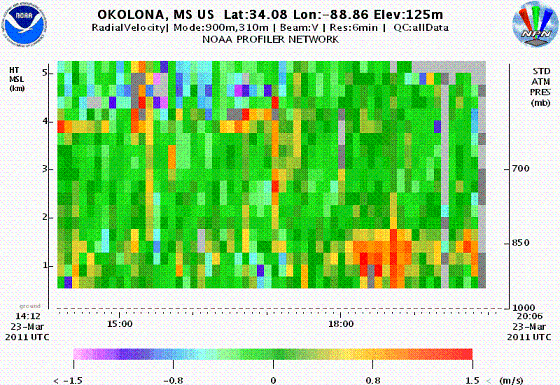Why is the wind so gusty?
It is a windy day across Alabama, due to the fairly large pressure gradient in place between high pressure to our south and low pressure to our north. But, why does the wind gust? Since the pressure gradient force is almost constant, why do winds vary from as low as 10 mph at times, to as high as 33 mph at others? And why does the wind calm down and get less gusty at night, in general?
Take a look at the surface observations of wind from BHM since 1153Z (653 am CDT). The first three numbers are the direction the wind is coming from (220 is southwest), and the number after that is the average wind speed in knots, with a top gust in the past hour listed if it varies by more than a few knots (1 knot = 1.15 mph)
KBHM 231153Z 220/08KT
KBHM 231253Z 200/10KT
KBHM 231353Z 220/17G22KT
KBHM 231453Z 230/10G22KT
KBHM 231553Z 210/16G22KT
KBHM 231653Z 240/13G24KT
KBHM 231753Z 240/19G29KT
KBHM 231853Z 240/15G26KT
KBHM 231953Z 230/19G24KT
Here are winds (average in blue, instantaneous gust in yellow) at UAH.
Early this morning, winds were lighter and less gusty. But, once the sun came out, winds increased quickly by 15Z (10 am), gusting to 22 knots (about 25 mph). It all has to do with mixing and friction. Because the ground exerts friction on the air, winds are slower near the ground than they are aloft even given the same pressure gradient. The effect of friction tails off as you go upward, to a point (somewhere between 2,000 and 5,000 feet usually) where friction no longer effects the wind. This layer is known as the boundary layer.
At night, when there is no mixing in the boundary layer, the higher winds mainly stay aloft. But, when the sun comes out, it warms the ground unevenly, and turbulence develops as warm air rises and cool air sinks, keeping the boundary layer what we call “well-mixed”. This vertical motion brings some of the higher momentum air down to the ground, and it varies as upward and downward motion goes by. The wind speed often peaks around 11 am or so, as some of the stored up momentum right above the surface gets mixed down, and from then on everything is well-mixed.
Below is a wind profiler time vs. height section of upward/downward motion vs. time today. Notice there are up and down motions with periods of less than 12 minutes, and some of the motions are up to 1 m/s (2 mph).
Category: Alabama's Weather, Met 101/Weather History




















